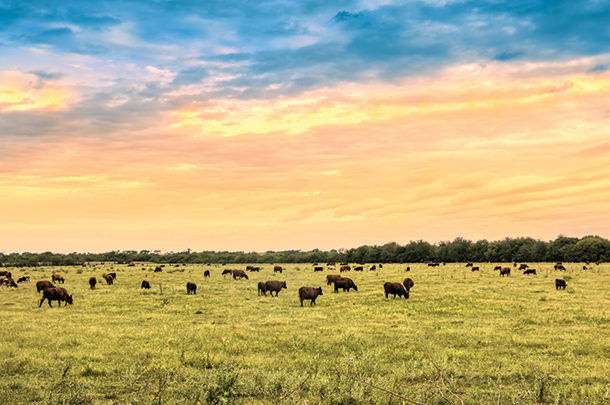What’s the right thing when it comes to raising beef? After all, ultimately we are raising food a person will eat, not just raising the cow that produces it. With that responsibility then, what does doing the right thing look like in raising beef?
To me, it’s summed up in stockmanship and stewardship, which essentially means taking good care of the livestock entrusted to us. Many folks are familiar with Paul Harvey’s statement from 1978, “And on the eighth day, God looked down on his planned paradise and said, ‘I need a caretaker.’ So God made a farmer.”
According to the Bible, man was actually created on the sixth day and God made him steward of creation. Genesis 2:15 says, “And the LORD God took the man, and put him into the garden of Eden to dress it and to keep it.” (KJV) To me, that means our job of taking care of God’s creation is a divine charge worthy of our best effort. “And whatsoever ye do in word or deed, do all in the name of the Lord Jesus, giving thanks to God and the Father by him.” (Colossians 3:17 KJV). And there are Bible verses that exhort us to look after our livestock. “Be thou diligent to know the state of thy flocks, and look well to thy herds.” (Proverbs 27:23 KJV).
So if I am a steward with a divine calling, what is the right thing to do?
The Beef Quality Assurance (BQA) logo says, “The right way is the only way.” While BQA started out more than three decades ago with the purpose of reducing residues and blemishes in meat, it has developed to a total quality approach to raising beef. The National Cattlemen’s Beef Association (NCBA) estimates there are a little over 725,000 beef cattle farms in the U.S. In 2017, there were just over 200,000 people BQA-certified.
Today, there are dozens of certification programs about raising and marketing quality beef. All of them are designed to show the consumer that we are careful about how we produce the beef we sell, we follow high standards in raising this beef, we stand behind it, and we want you to be confident in the product you buy, in that it was raised humanely and sustainably, and it is safe and wholesome for your family to eat.
Best practices for raising beef have essentially two main, often overlapping points: applying proven, best management practices on the farm and attending to animal well-being. For decades, studies have shown improved animal health and performance using simple, time-tested preventive practices such as weaning and vaccination.
Yet, in the 2017 USDA Beef Cow-calf Management report, only about half the calves born in the Southeast were vaccinated or castrated before marketing through an auction market. We clearly have a ways to go when it comes to managing our calves.
Preventable diseases are the number one issue for animal health and welfare. Proper nutrition, timely vaccinations, weaning and castrating bull calves when they weigh less than 200 pounds have shown to improve calf health and reduce need for antibiotic use.
Not only that, but calves managed like this bring premiums at Southeast auction markets. In a recent study, a student at Emmanuel College in Georgia compared calves sold through a local weekly auction market to a value-added calf sale that had a required health program for calves to be eligible for their sale. He compared prices for similar calves.
For instance, he compared a 450-pound bred heifer calf sold through a regular weekly sale with a red heifer of approximately the same weight sold through the special sale. No bulls were allowed in the value-added sale. What he found was: Calves sold in the sale requiring a documented health program brought an average of 16 cents more per pound than at the weekly sale. That’s an $80 difference on a 500-pound calf. So with that difference in price, why don’t more producers vaccinate and castrate calves?
I’ve heard that some farmers think bull calves weigh more at weaning than steer calves. For the week ending July 13, 2020, medium and large No. 1 steers weighing 550 to 599 pounds brought almost 10 cents more per pound on average than a similar-weight bull. Even though research has shown the weight advantage for intact bull calves doesn’t begin until 600 to 700 pounds, nearly half of Georgia producers still leave bulls intact and give up $10 per 100 pounds or an average of $50 per bull sold. Add to that the difference of a health program, and that’s about $130 per head in income they are giving to someone else.
Vaccination programs can be confusing, and there are literally hundreds of vaccines to sort through. What vaccines and when to give them are frequent questions I get from farmers. I prefer to keep the program simple. Common vaccines recommended include the respiratory viruses and the clostridial vaccine or blackleg shot (7-way). Others might include pinkeye, scours or the respiratory bacteria. I have written other articles about vaccination recommendations and programs, so I won’t repeat that here.
Farmers also ask about dewormers. Due to the overuse of common, cheap generic pour-on dewormers, we frequently deal with resistant intestinal parasites. We now recommend farmers use an oral drench, “white wormer” with an injectable dewormer at the same time.
It is absolutely imperative we use the right dose when deworming cattle, so having a set of scales to weigh and calculate the dose is very helpful. While it is a bit more expensive to double deworm, it is way more effective than the traditional pour-on. Also, farmers can save money by not deworming older cows in very good body condition, so that’s a beneficial trade-off.
Perhaps farmers don’t work their cattle due to a lack of facilities. Facilities make a big difference in working cattle. Proper design and upkeep make working cattle much easier than poorly designed and broken-down equipment and pens. Properly designed facilities accommodate cattle’s natural behavior and encourage their cooperation when working. Cattle facilities don’t have to be super-expensive, but they do need to be adequate, sturdy and adjustable for working different classes of animals.
Many producers really like the Bud box design. This design was named after a low-stress livestock handling expert, Bud Williams. He noticed several natural behaviors of cattle and recommended a design to take advantage of the way cattle naturally respond to human pressure. A quick internet search will show several designs using the Bud box principles. Many producers who have adapted this design have remarked how easy cattle are to work, with much less hassle and pressure or use of electric prods.
Low-stress handling is a must. There are several low-stress handling workshops now across the U.S. This practice has become widely accepted and adopted as the new standard for working cattle. Several studies have proven the benefits of using low-stress techniques on livestock health and performance. Like the facility design, low-stress handling uses cattle’s natural tendencies to handle cattle when working through the handling equipment. There is a common saying, “Slower is better.” What that means is: Not getting in a big hurry and applying too much pressure on cattle actually makes the process go smoother and even faster.
Many times, some folks struggle to make any money in a cow-calf operation. In fact, many cow-calf farmers are lucky to show a profit in an average year. For them, the cow-calf business might not be the best fit. Perhaps they’d be better off grazing stockers or yearlings or renting their pasture and facilities.
I often see farms with very short grass. One farmer I worked with had about 45 cows but only sold 30 calves each year. I recommended only keeping cows that produced calves. After culling through some unproductive cows, he now sells almost the same number of calves as he has cows, and his cows are in much better shape. He adjusted his cattle numbers to his resources. That not only saved in reducing his feed bill but increased the resources for his productive cows. Adequate nutrition doesn’t have to be complicated. In fact, many farmers can carry a few less cows and stretch their grazing to reduce purchased feed, thereby saving money.
Doing the right thing is always the right thing to do. There’s hundreds of quotes about doing the right thing, and many are tied to integrity. Most of us would argue that truth and honesty aren’t relative (your truth isn’t different than mine), and integrity shouldn’t be for sale. Does that apply to raising cattle and selling beef? Do we cut corners for sake of profit or convenience? Or are we always doing the right thing by our cattle, for our operation and for the industry and consumers?
We are in a time where doing it right also means getting paid more for our calves. Even though the COVID-19 virus had a negative impact on our markets for early 2020, markets are still pretty good for properly managed calves with a documented health program. Check with your local sale barn to find out if they have a special calf sale and work with your veterinarian to design a health program that keeps calves and cows healthy and captures premiums for value-added sales.








